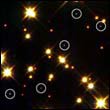
White dwarfs cooler than 20000 K have very thin atmospheres. Consequently,
in these high gravity stars, heavy elements sink and become undetectable on
a time scale of less than 1000 years. While 75% of cool white dwarfs have
calcium abundances less than 10^-6 of the Sun’s, about 25% of these stars
have at least some detectable calcium. One model is that white dwarfs with
metals are accreting them from the interstellar medium. Alternatively, the
white dwarfs could be accreting from the dust produced by the disintegration
of comets and the destruction of asteroids. Accretion rates as low as 3
106 g s^-1, the rate at which dust is manufactured to produce the zodiacal
cloud in the Solar System are detectable. Infrared emission from the dust
around white dwarfs can be used to study their circumstellar matter. We
describe how the previous detection of an infrared excess around the white
dwarf G29-38 and our recent detection of an infrared excess around GD 362
can be used to investigate systems of asteroids and planets around these
stars.
To join using a videoconferencing system:
Please RSVP to Mike Toillion (mike.toillion@nasa.gov) if you will be joining by Polycom.
To view the slides, connect to http://connect.arc.nasa.gov/nai_directors_seminar/
To join using a web browser:
The slides and audio/video for this meeting will be presented using Adobe Connect. To join the meeting, connect to:
http://connect.arc.nasa.gov/nai_directors_seminar/
If you are having problems connecting, you can try joining http://connect.arc.nasa.gov/nai_directors_seminar/?launcher=false, or rebooting your computer, or try joining from another network.
 A Talk With Jim Green
A Talk With Jim Green What Can Extant Genomes Reveal About Early DNA Metabolism?
What Can Extant Genomes Reveal About Early DNA Metabolism? What We Talk About When We Talk About Earth's Oxygenation
What We Talk About When We Talk About Earth's Oxygenation Bowling With Astrobiologists: A Twisted Path Toward the Origin of DNA
Bowling With Astrobiologists: A Twisted Path Toward the Origin of DNA